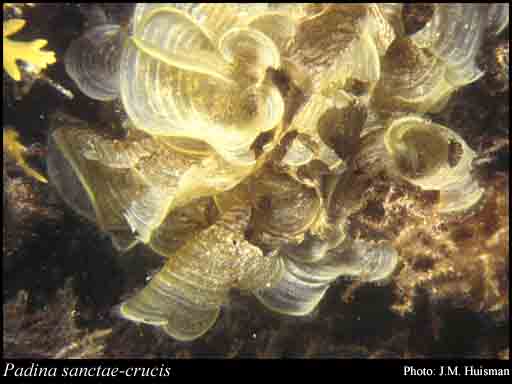- Reference
- Dansk Bot.Ark. 2(2):45, Figs 27-28 (1914)
- Conservation Code
- Not threatened
- Naturalised Status
- Native to Western Australia
- Name Status
- Current

Scientific Description
Habit and structure. Thallus medium brown throughout, lightly calcified, more so on the upper surface, 5–15 cm long and 5–25 cm in spread, when young flabellate, remaining so or becoming divided with flabellate to occasionally cuneate segments 1–5 cm broad above, with rounded axils, attached by a rhizoidal holdfast 0.5–2 cm long and 2–5 mm across; epilithic? Structure of two layers of cells throughout, 100–150 µm thick near the apices and 150–200 µm thick below, with the upper cells (1.2–)1.5–1.8 times the height of the lower cells. Cells in surface view of upper side 30–40 µm broad, L/B (1–)1.5–2, on lower side 24–30 µm broad, L/B (1–)1.5–2. Hairs in alternating concentric lines on both sides of the thallus, 2–3 mm apart on each side, 20–25 µm in diameter.
Reproduction. Sporangia in concentric, continuous or broken, relatively linear sori on the lower side of the thallus, above each of the hair lines but with alternate fertile and sterile zones when the hair lines on both sides are viewed together; indusium slight; sporangia ovoid, 140–170 µm long and 60–120 µm in diameter. Sexual plants unknown on Australian coasts, dioecious with sori of oogonia or antheridia.
Distribution. In Australia, known from the tropics south to Augusta, W.Aust., with one specimen from Point Sinclair in S. Aust.
[After Womersley, Mar. Benthic Fl. Southern Australia II: 219 (1987)]
Distribution
- IMCRA Regions
- Bonaparte Gulf, Canning, Central West Coast, Kimberley, Leeuwin-Naturaliste, Pilbara (offshore).
- Local Government Areas (LGAs)
- Ashburton, Augusta Margaret River, Broome, Cockburn, Dandaragan, Irwin, Northampton, Wyndham-East Kimberley.